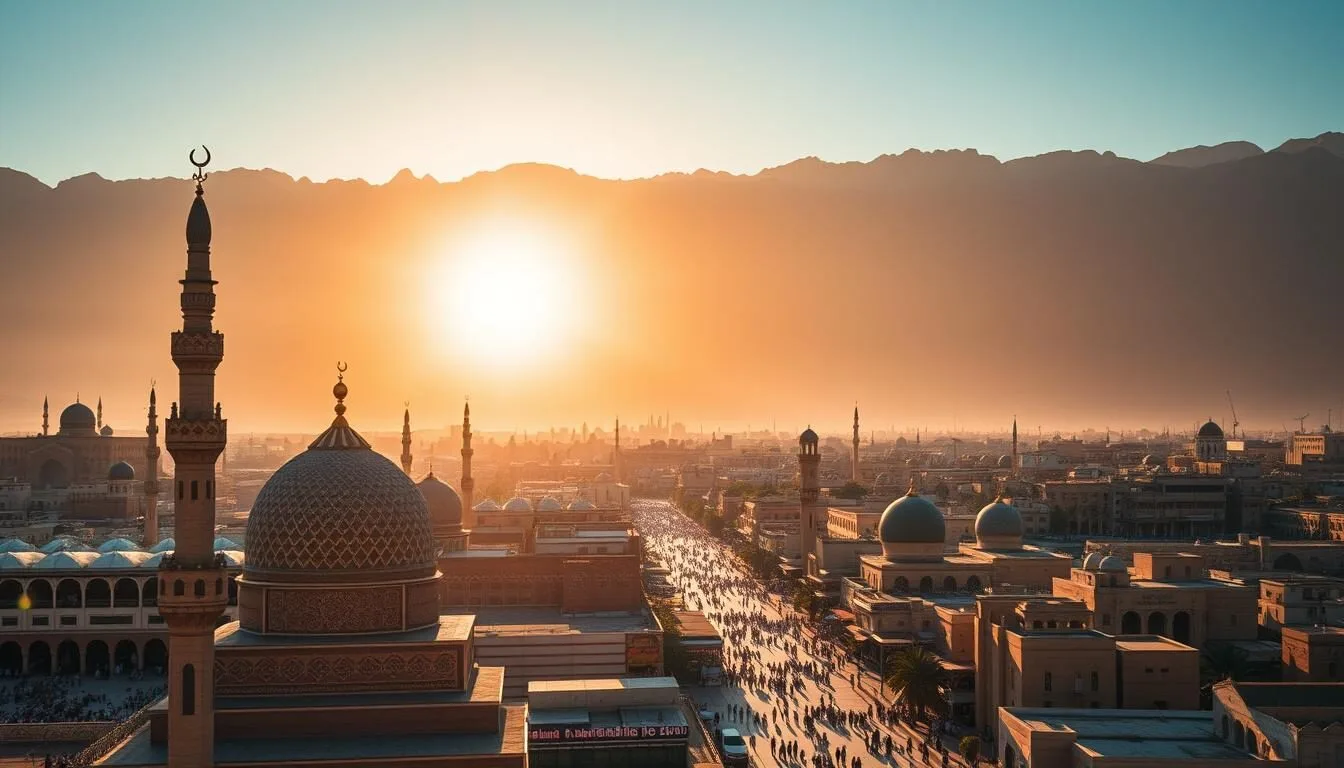✓ Accommodations✓ Flights✓ Rental Cars
Are you ready for a journey to a city that embodies the essence of Islamic heritage and culture? Medina, Saudi Arabia, is a destination that promises a deeply enriching experience.
This holy city is not just a place of worship but a treasure trove of history, where the legacy of Prophet Muhammad is palpably felt. As the second holiest city in Islam, Medina attracts millions of pilgrims and travelers seeking a connection to the divine.
As you explore Medina, you’ll uncover its vibrant markets, historic landmarks, and sacred sites, including the magnificent Prophet’s Mosque. This comprehensive guide will walk you through the best things to do in Medina, ensuring your visit is both memorable and respectful.
The Holy City of Medina: An Overview
You are about to explore one of Islam’s most revered cities, Medina, a place of profound historical and religious significance. Medina is a city filled with Islamic history and deep religious meaning, making it a unique destination for those interested in exploring the rich spiritual and cultural heritage of Saudi Arabia.
Historical Significance and Religious Importance
Medina holds immense historical significance as the city where Prophet Muhammad established the first Islamic community after migrating from Mecca in 622 CE. As the second holiest city in Islam, Medina has been a center of Islamic learning and culture for over 1,400 years. The city’s religious importance stems from being the final resting place of Prophet Muhammad and home to numerous sites connected to early Islamic history. Medina has played a pivotal role in the development and spread of Islam throughout Saudi Arabia and the world.
| Aspect | Significance |
|---|---|
| Historical Importance | Establishment of the first Islamic community by Prophet Muhammad |
| Religious Significance | Final resting place of Prophet Muhammad |
| Cultural Impact | Center of Islamic learning and culture for over 1,400 years |
Best Time to Visit Medina
The best time to visit Medina is during the winter months (November to February) when temperatures are mild and comfortable for exploring. Summer months (May to September) bring extreme heat, making outdoor exploration challenging, while Ramadan and Hajj seasons see large crowds of pilgrims. Consider visiting during spring (March-April) or autumn (October-November) for pleasant weather and fewer crowds.
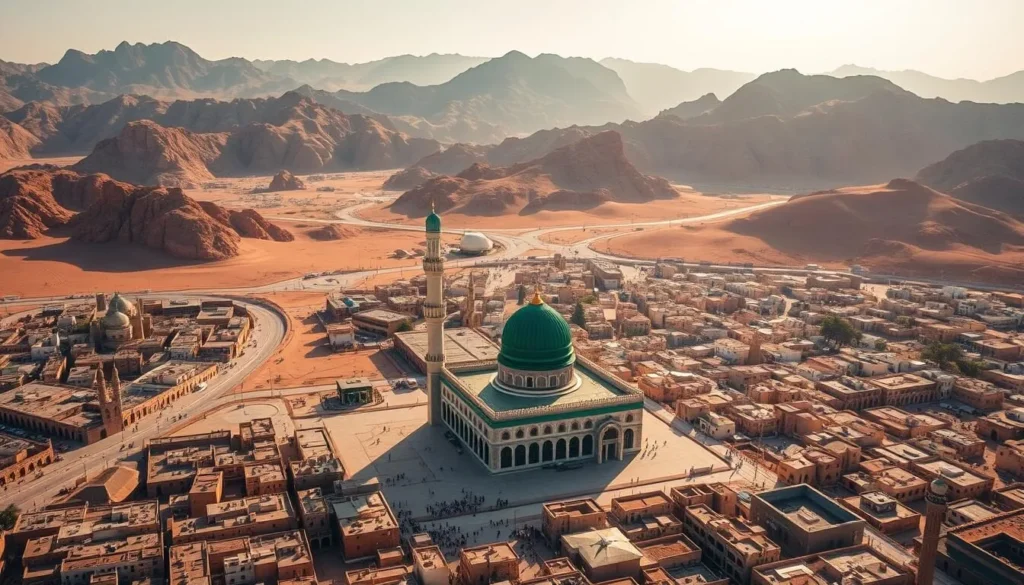
Throughout its history, Medina has preserved its spiritual character while evolving into a modern city that welcomes millions of visitors annually. Planning your visit according to the weather and religious calendars can enhance your experience in this sacred city.
Getting Around Medina
Getting around Medina is a breeze, thanks to its comprehensive network of taxis, buses, and ride-sharing services. The city’s infrastructure is designed to accommodate the needs of pilgrims and tourists, making it easy to explore its many attractions.
Transportation Options
Medina offers a range of transportation options to suit different preferences and budgets. You can use taxis, which are abundant and convenient, with many drivers speaking basic English to assist tourists. The city’s bus network is another affordable option, with routes connecting major landmarks, although schedules may vary throughout the day.
- Taxis provide a convenient door-to-door service.
- Buses offer an affordable way to travel between major sites.
- Ride-sharing apps are increasingly available, offering set pricing.
Navigating the City Center
Navigating Medina’s city center is relatively straightforward, with many attractions within walking distance, particularly around Al-Masjid an-Nabawi. Be aware that certain areas may have restricted access during prayer times, so plan your movements accordingly. Many hotels in Medina, Saudi Arabia, offer complimentary shuttle services to major religious sites, making it even easier to get around.
| Mode of Transport | Convenience | Cost |
|---|---|---|
| Taxis | High | Moderate |
| Buses | Medium | Low |
| Ride-sharing Apps | High | Moderate |
| Walking | High | Free |
Al-Masjid an-Nabawi: The Prophet’s Mosque Experience
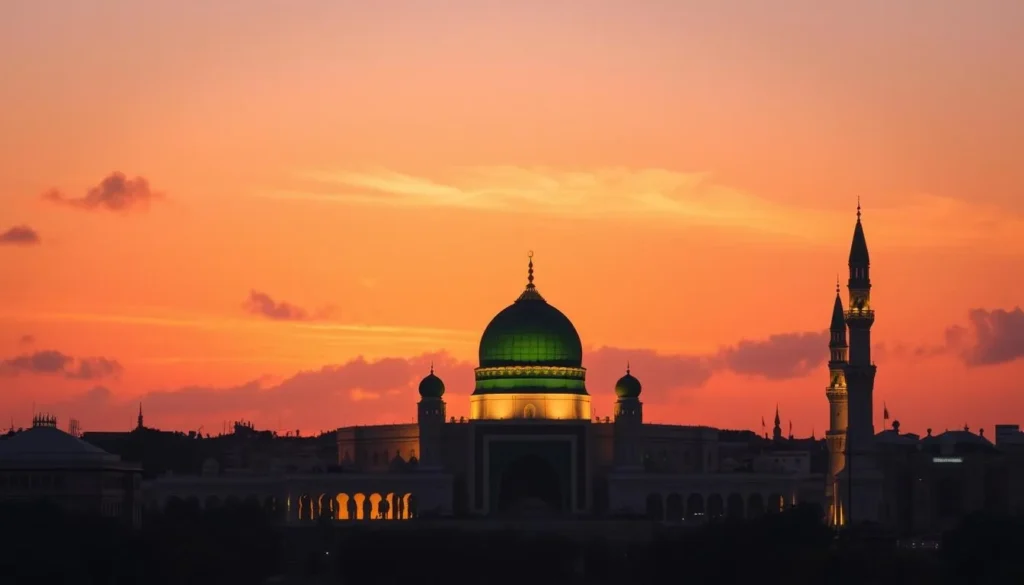
As you step into the heart of Medina, Saudi Arabia, you’re immediately drawn to Al-Masjid an-Nabawi, a site of immense historical and spiritual significance. The Prophet’s Mosque, built by Prophet Muhammad in 622 CE, is a marvel of Islamic architecture and a must-visit destination.
The Green Dome and Sacred Chamber
The iconic Green Dome is a striking feature of Al-Masjid an-Nabawi, marking the location of Prophet Muhammad’s tomb. This sacred area is considered one of the most revered spots in the Islamic world. The Rawdah, or Garden of Paradise, is another significant area within the mosque, situated between the Prophet’s tomb and his pulpit.
The mosque complex is renowned for its stunning Islamic architecture, featuring intricate calligraphy, marble columns, and beautiful chandeliers. Visitors can explore the large courtyard, peaceful gardens, and refreshing fountains, creating a serene atmosphere that fosters deep spiritual connection.
Etiquette and Guidelines for Visitors
When visiting Al-Masjid an-Nabawi, it’s essential to observe proper etiquette. This includes dressing modestly, removing shoes before entering the mosque, and maintaining respectful silence. Guided tours are available to help visitors understand the historical and spiritual significance of different areas within the mosque complex.
Non-Muslims are not permitted to enter the central area of the mosque but can appreciate its magnificent architecture from designated areas. The mosque’s expansive halls and beautiful gardens are a testament to Islamic heritage and culture.
Quba Mosque: The First Mosque in Islam
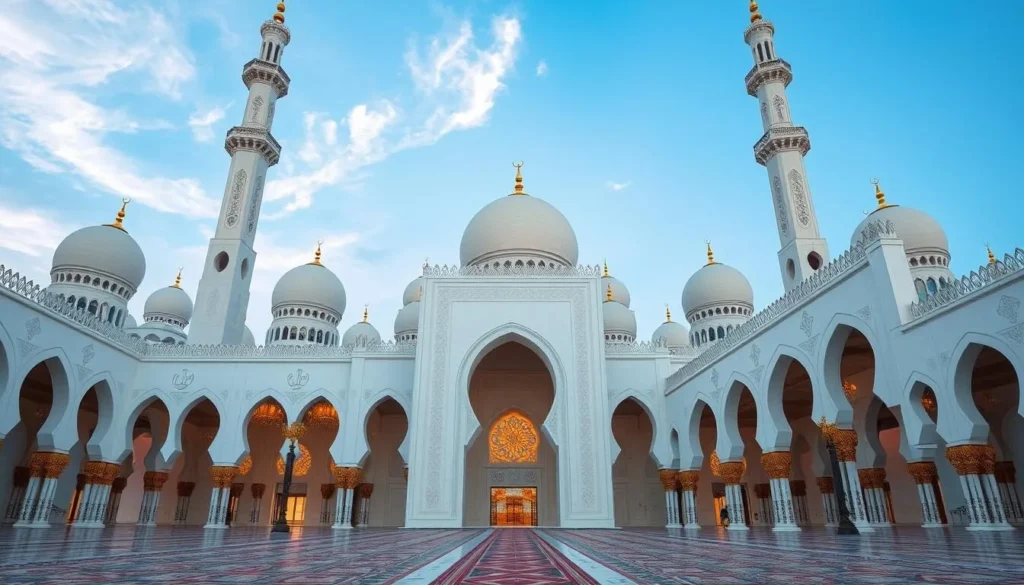
As you approach the Quba Mosque, you’re stepping into a piece of Islamic heritage that dates back to the time of Prophet Muhammad. This historic mosque is not only a significant religious site but also a place of great architectural beauty.
Historical Significance
The Quba Mosque holds a special place in Islamic history as it was the first mosque built in Islam, established by Prophet Muhammad upon his arrival in Medina in 622 CE. According to Islamic tradition, praying at Quba Mosque is equivalent to performing an Umrah, making it a significant spiritual destination for Muslims worldwide. The mosque has been renovated and expanded several times throughout history, preserving its historical significance while incorporating modern amenities.
Visitor Information
Located about 5 kilometers from Medina’s city center, the Quba Mosque is easily accessible. It is open daily to both Muslims and non-Muslims, though visitors are expected to dress modestly and behave respectfully. The best times to visit are early morning or late afternoon when temperatures are cooler and the mosque is less crowded. Photography is permitted in most areas, allowing you to capture the beauty of this important landmark in Islamic history.
Sacred Sites and Historical Landmarks in Medina
As you explore Medina, you’ll discover a wealth of sacred sites and historical landmarks that are pivotal to understanding Islamic history. Medina, the holy city of Islam, is filled with places that show the early days of Islam, connecting visitors to the past.
Jannat al-Baqi Cemetery
Jannat al-Baqi is one of Islam’s most significant cemeteries, where many of Prophet Muhammad’s family members, companions, and early Islamic figures are buried. This site holds immense spiritual significance for Muslims worldwide who visit to pay their respects. Though simple in appearance, Jannat al-Baqi is a place of deep reverence.
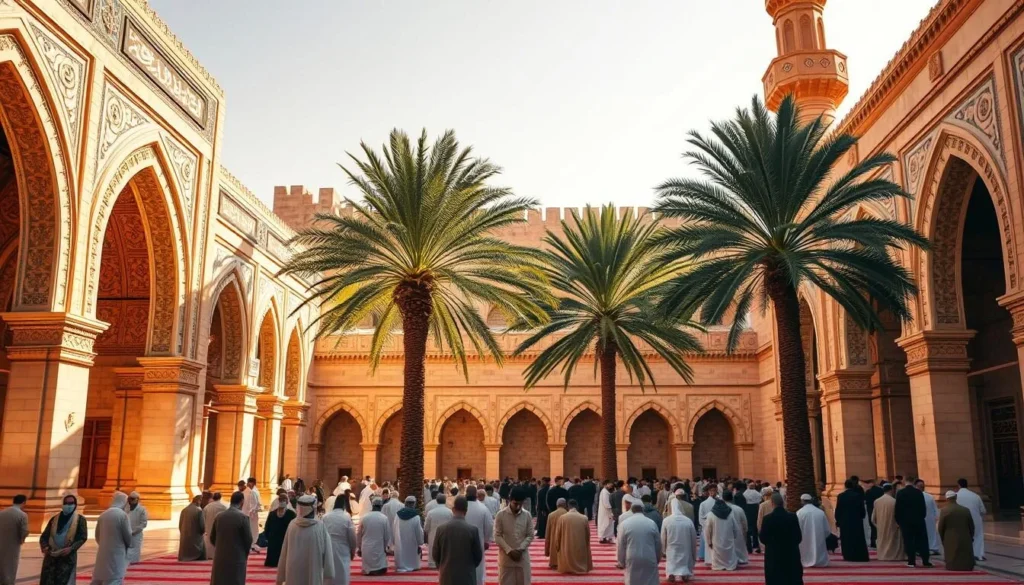
The cemetery is a reminder of the rich history of Islam and the importance of Medina as a sacred city. Visitors can pay their respects and reflect on the historical significance of the site.
Mount Uhud Battlefield
Mount Uhud, located about 5 kilometers north of Medina, was the site of the famous Battle of Uhud in 625 CE, a pivotal event in Islamic history. Visitors to Mount Uhud can explore the battlefield, visit the graves of martyrs, and enjoy panoramic views of Medina from its slopes.
The battle was a key moment in Islam’s early years, and the site remains a significant historical landmark. The bravery and sacrifices made during the Battle of Uhud are remembered and honored by Muslims around the world.
| Landmark | Significance | Visitor Experience |
|---|---|---|
| Jannat al-Baqi Cemetery | Burial site of Prophet Muhammad’s family and companions | Pay respects, reflect on historical significance |
| Mount Uhud Battlefield | Site of the Battle of Uhud in 625 CE | Explore battlefield, visit martyr graves, panoramic views |
| The Seven Mosques | Commemorates the Battle of the Trench | Visit historic mosques, understand historical context |
The Seven Mosques (Sab’a Masajid)
The Seven Mosques are a collection of small, historic mosques built to commemorate the Battle of the Trench, another significant event in early Islamic history. These mosques provide a tangible connection to the formative period of Islam and the life of Prophet Muhammad in Medina.
Visiting these sacred sites requires respectful behavior and modest dress, as they are places of deep religious significance. Understanding the historical context and significance of these landmarks enhances the visitor’s experience.
Traditional Markets and Shopping Areas
The traditional markets of Medina offer a unique glimpse into the city’s rich history and commercial heritage. Whether you’re looking for local delicacies, traditional crafts, or simply want to experience the vibrant atmosphere, Medina’s souks are a must-visit destination.
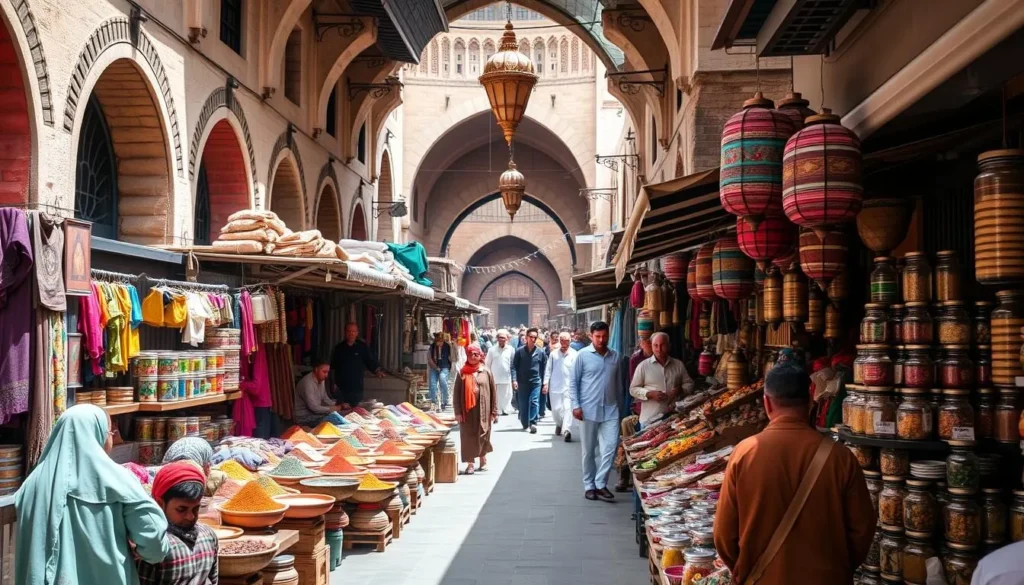
Al-Madina Dates Market
The Al-Madina Dates Market, located near the Prophet’s Mosque, is a must-see destination for anyone visiting Medina, Saudi Arabia. Here, you can sample and purchase various types of dates, including the famous Ajwa dates believed to have healing properties. The market features hundreds of vendors selling different varieties of dates, honey, and other local delicacies.
Souvenirs and Traditional Crafts
Medina’s traditional souks offer a treasure trove of options for souvenirs and traditional crafts. You can browse through shops selling prayer beads, Islamic calligraphy, handcrafted jewelry, traditional clothing, and aromatic oils and perfumes. Bargaining is expected and part of the shopping experience in these traditional markets, so don’t hesitate to negotiate prices.
Many shops close during prayer times and reopen afterward, so plan your shopping excursions accordingly. For a more modern shopping experience, Medina also has contemporary malls that offer international brands alongside traditional Saudi products.
Cultural Experiences in Medina, Saudi Arabia: Best Things to Do – Top Picks
When visiting Medina, you’re not just exploring a city; you’re immersing yourself in a vibrant cultural landscape. Medina, Saudi Arabia, is a city that seamlessly blends tradition with modernity, offering something for everyone to enjoy. As the second holiest city in Islam, Medina is steeped in history and religious significance, making it a unique destination for travelers from around the world.
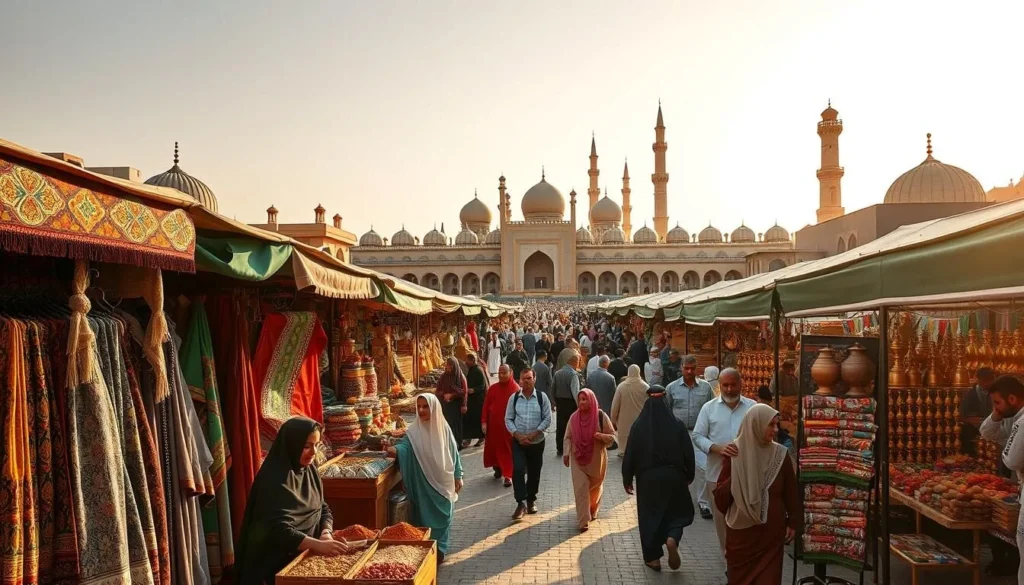
Local Customs and Etiquette
Understanding and respecting local customs and etiquette is crucial when visiting Medina. The city is known for its hospitality, and visitors are encouraged to reciprocate this warmth with respect. Dressing modestly is a must, especially when visiting sacred sites like the Prophet’s Mosque. This means covering your arms and legs and, for women, considering the use of a headscarf. Greeting locals with a handshake and using honorific titles is also appreciated. By showing respect for these customs, you can have a more meaningful and enriching experience in Medina.
- Dress modestly, covering arms and legs.
- Use honorific titles when greeting locals.
- Respect prayer times, as many businesses close briefly during these periods.
Traditional Saudi Cuisine
Medina’s culinary scene is a highlight of any visit, offering a range of traditional Saudi dishes that are both flavorful and authentic. Kabsa, a rice dish cooked with meat and spices, and Mandi, a slow-cooked meat and rice dish, are must-try specialties. Visitors can sample these and other local flavors at authentic restaurants and markets around the city. Don’t miss the opportunity to try fresh dates, Arabic coffee, and traditional sweets, which are an integral part of Saudi hospitality.
- Try Kabsa and Mandi for authentic Saudi flavors.
- Visit local restaurants and markets for a culinary experience.
- Enjoy fresh dates, Arabic coffee, and traditional sweets.
Cultural Performances and Events
Throughout the year, Medina hosts various cultural events and exhibitions that showcase the rich heritage and Islamic faith of the region. The Prophet’s Mosque area often features calligraphy exhibitions, Islamic art displays, and occasional cultural performances. Visiting during major Islamic festivals like Eid can be a particularly vibrant experience, though it’s wise to be prepared for larger crowds. Engaging with locals respectfully can also provide deeper insights into the cultural significance of Medina.
In Medina, Saudi Arabia, there’s a wealth of cultural experiences waiting to be discovered. Whether it’s through respecting local customs, savoring traditional cuisine, or enjoying cultural performances, visitors can have a truly enriching experience in this historic city.
Green Spaces and Outdoor Activities
Beyond its religious significance, Medina boasts beautiful green areas where visitors can unwind and enjoy the outdoors. These serene spaces offer a welcome respite from the city’s bustling religious and historical sites.
Green Dome Park
Green Dome Park is a must-visit attraction in Medina, covering over 100 acres. This beautiful oasis features lush gardens, walking paths, and picnic spots, making it an ideal location for outdoor recreation. Visitors can take a leisurely stroll, enjoy a picnic with family, or simply relax amidst the tranquil surroundings. The park’s well-manicured landscaping and facilities make it a favorite among locals and tourists alike.
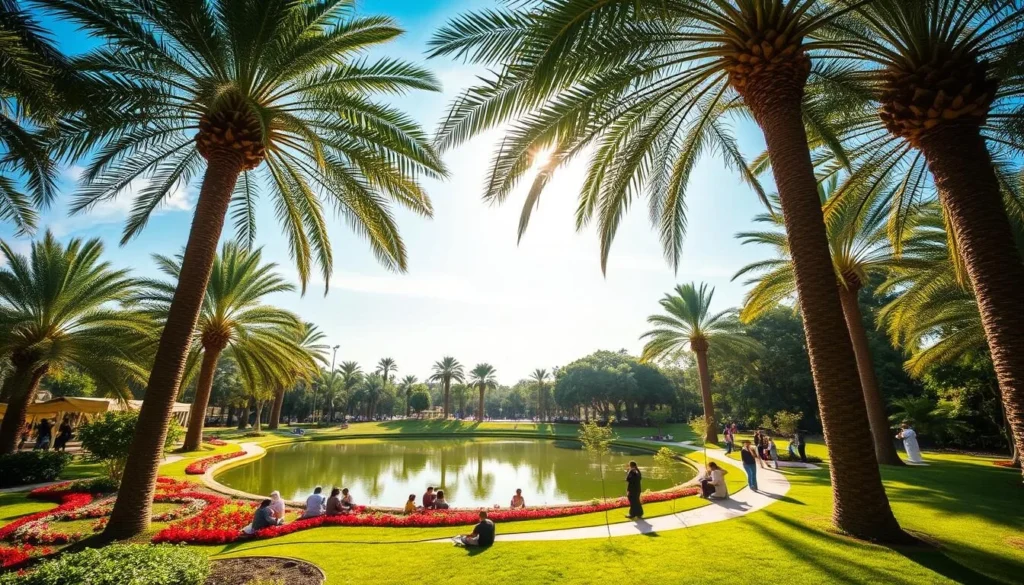
Prince Mohammed bin Abdulaziz Park
Another gem in Medina’s crown is the Prince Mohammed bin Abdulaziz Park, named after the former governor of Madinah Province. This park is a premier green space, offering beautifully landscaped gardens, water features, and children’s play areas. Visitors can enjoy walks, picnics, and various recreational activities in a peaceful setting. The park is particularly popular in the evening when temperatures cool down, and families gather for social activities. It’s a great spot for photography, with its scenic backdrops and well-designed landscaping.
Both Green Dome Park and Prince Mohammed bin Abdulaziz Park provide a serene atmosphere, allowing visitors to relax and rejuvenate. Remember to respect local customs and dress modestly when visiting these public spaces.
Museums and Educational Centers
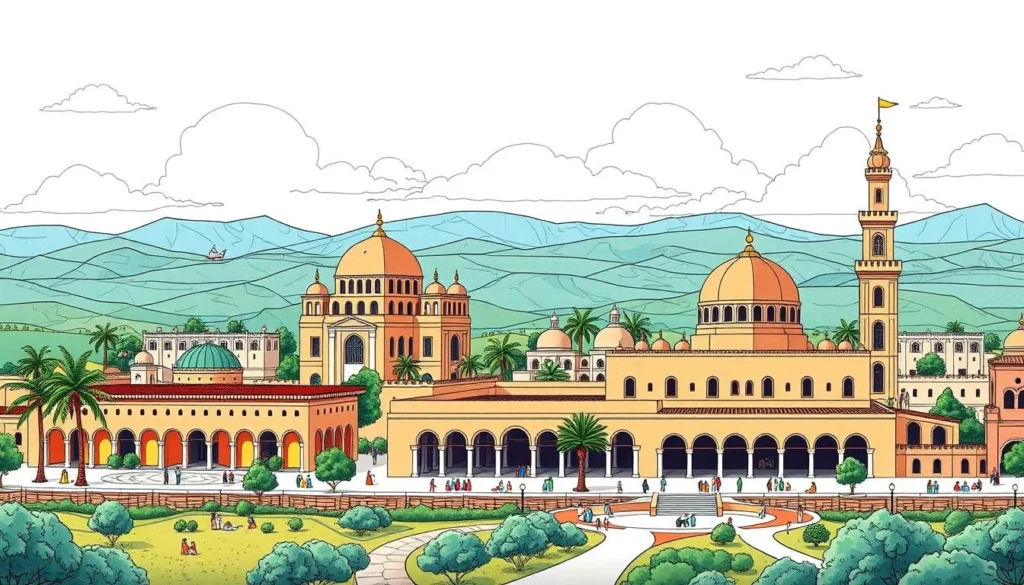
Medina is home to a wealth of museums and educational centers that offer a glimpse into its rich Islamic heritage. Visitors can dive into the city’s history by exploring these institutions, which provide deep insights into Medina’s role in Islamic civilization.
Al-Madinah Museum
The Al-Madinah Museum is a key spot for those interested in Medina’s museums and Islamic heritage. Located in the old Al-Hejaz Railway Station, the museum boasts 14 galleries that explore Medina’s history, from the rise of Islam to the region’s natural wonders. You can see ancient artifacts, manuscripts, and interactive exhibits that make Medina’s history come alive.
Key Features: The museum features displays on the Prophet’s life, the spread of Islam, and Medina’s role as a center of Islamic learning throughout history. Interactive exhibits and multimedia presentations make the Al-Madinah Museum engaging for visitors of all ages and backgrounds.
Hejaz Railway Museum
The Hejaz Railway Museum gives a unique look at the railway network that once linked Medina to Damascus. This educational attraction shows the engineering, cultural, and strategic importance of this historic transportation system. It played a big role in the region’s growth.
Exhibits: The museum documents the fascinating history of the Ottoman-built railway that connected Damascus to Medina. Exhibits include original locomotives, carriages, equipment, and photographs that tell the story of this engineering marvel and its impact on pilgrimage and commerce.
Both museums offer guided tours in multiple languages, providing deeper context about the exhibits and their significance to Islamic history. Allow at least 1-2 hours for each museum to fully appreciate the collections and historical narratives they present.
Modern Medina Attractions
Medina, a city steeped in history and spirituality, also offers a modern face to its visitors. Beyond its ancient mosques and historical sites, Medina boasts an array of contemporary attractions.
Shopping Malls and Entertainment
You can enjoy shopping, dining, and entertainment at modern malls like Al Noor Mall and Rashid Mega Mall. These malls offer a mix of international brands and local products, providing a unique shopping experience.
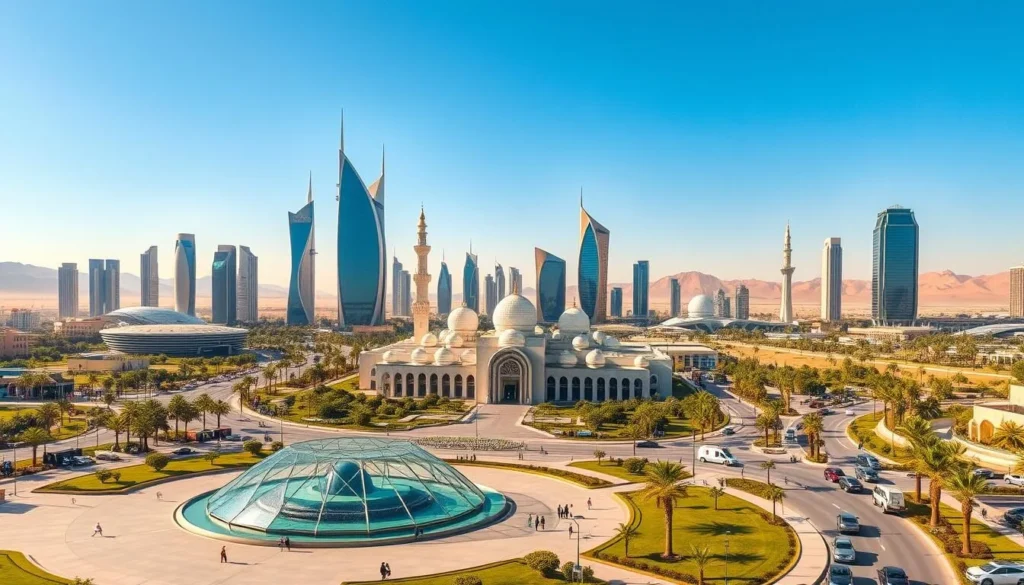
The city’s modern architecture blends traditional and contemporary styles, as seen in the Knowledge Economic City.
Spiritual Tourism and Religious Sites
For millions of pilgrims, Medina is a city of deep spiritual significance, where faith and history come alive. As you visit this sacred place, you’ll be surrounded by the rich history and teachings of Prophet Muhammad, peace be upon him.
Prayer Times and Visitor Guidelines
Understanding prayer times is crucial for planning your visit to Medina, as the city observes five daily prayers during which many sites and businesses temporarily close. The prayer times vary throughout the year based on the sun’s position, so it’s advisable to check current schedules through apps, hotel information, or local announcements.
When visiting religious sites, it’s essential to follow the guidelines: dress modestly (covering shoulders to knees for men, and full coverage except face and hands for women), remove shoes when required, and maintain respectful silence. Some areas, especially the holiest sites, are off-limits to non-Muslims, so always respect local customs and obtain the necessary permits before visiting these places.
| Prayer Time | Description |
|---|---|
| Fajr | Pre-dawn prayer |
| Dhuhr | Noon prayer |
| Asr | Afternoon prayer |
| Maghrib | Sunset prayer |
| Isha | Night prayer |
Lesser-Known Sacred Locations
Beyond the main attractions, Medina is home to several lesser-known sacred locations that hold significant meaning in Islamic faith and history. These include the Masjid al-Ijabah (Mosque of the Answer), where Prophet Muhammad, peace be upon him, made a special prayer that was answered by Allah.
Other notable sites are the Masjid al-Qiblatain (Mosque of the Two Qiblas), commemorating where the prayer direction was changed from Jerusalem to Mecca during the Prophet’s lifetime, and the Badr battlefield, marking the site of the first major victory for Muslims under the leadership of Prophet Muhammad, peace be upon him.
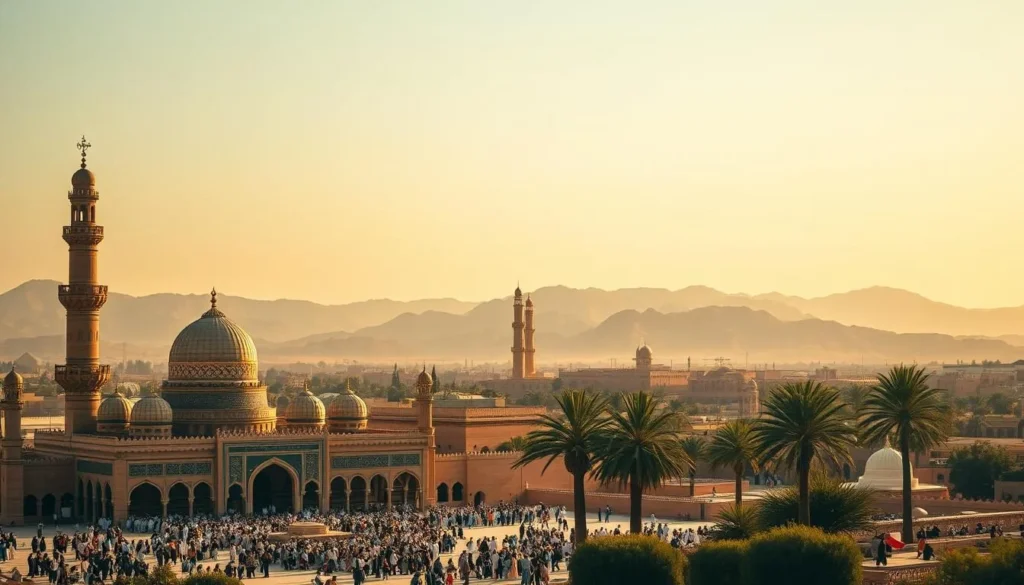
Day Trips from Medina
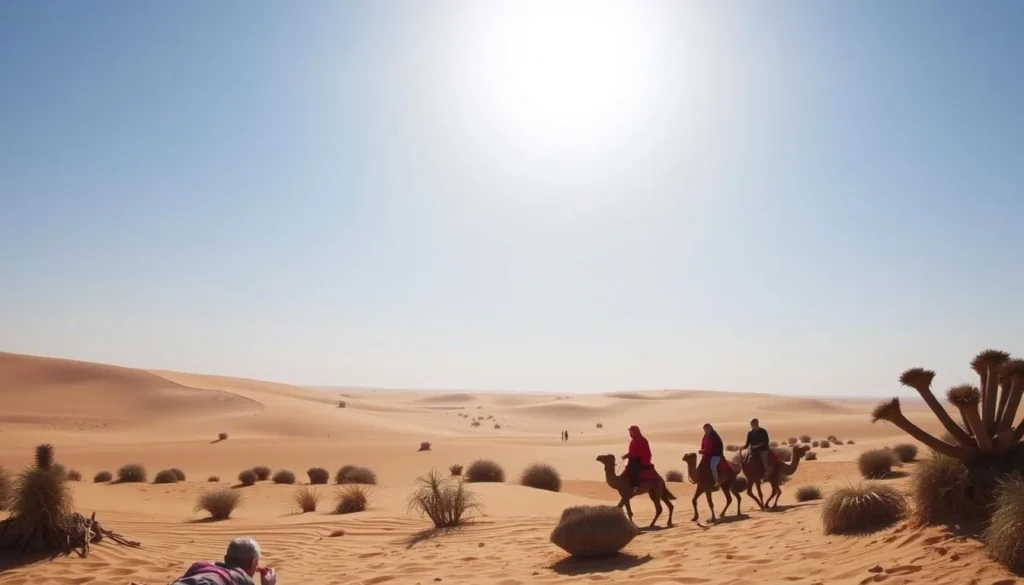
For those looking to experience the full breadth of Saudi Arabia’s natural beauty and history, Medina serves as an ideal base for day trips. The surrounding region is rich in diverse landscapes and cultural heritage, offering a wide range of exciting opportunities for exploration.
Exploring the Surrounding Areas
The area around Medina is dotted with unique archaeological, geological, and cultural sites. A popular day trip is to Al-Ula, located about 300 kilometers north of Medina, which offers unique archaeological sites including the UNESCO World Heritage site of Hegra (Madain Saleh). This ancient Nabatean city features spectacular rock-cut tombs, providing a deep connection to the region’s pre-Islamic history.
The volcanic fields of Harrat Rahat, south of Medina, provide an otherworldly landscape of black lava fields and dormant volcanic cones for those interested in geological wonders.
Desert Excursions
Desert excursions into the surrounding Arabian Desert offer opportunities to explore city like environments and experience traditional Bedouin culture, including camel rides, desert camping, and stargazing. These trips often include traditional meals and entertainment, providing insight into the nomadic lifestyle that has existed in this region for centuries.
When planning day trips, consider the climate and timing, as desert temperatures can be extreme during summer months. Most hotels and tourism offices in Medina can arrange guided day trips to these destinations, with transportation and expert guides included.
Where to Stay in Medina
When visiting Medina, choosing the right accommodation is crucial for a comfortable and enriching experience. The city offers a range of options to suit different budgets and preferences.
Luxury Accommodations
For those seeking a luxurious stay, hotels like the Oberoi Madina and Al Majeedi ARAC Resort offer exceptional amenities and stunning views of the Prophet’s Mosque. These hotels provide a high level of service, including fine dining options and comfortable rooms.
Budget-Friendly Options
For travelers on a budget, options like the Elaf Taiba Hotel and Dar Al Taqwa Hotel are available. These hotels offer comfortable accommodations at an affordable price, making them ideal for pilgrims and pilgrims who want to be close to the city’s central attractions.
Regardless of your budget, Medina has a range of accommodations to suit your needs. Consider booking in advance, especially during peak travel seasons.
Dining in Medina: Culinary Delights
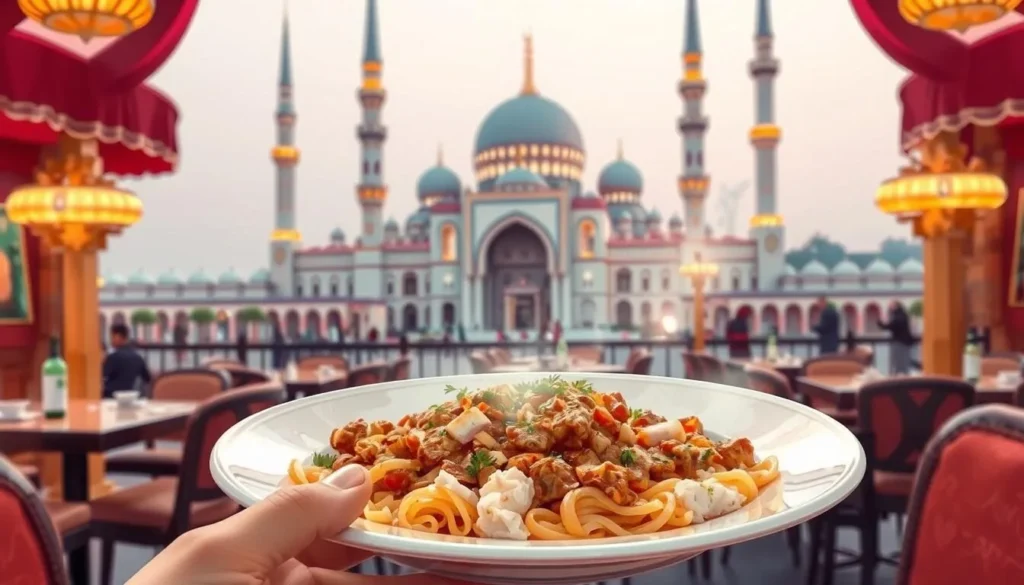
Medina, a city steeped in history and spirituality, also offers a culinary journey that reflects its rich heritage. As you explore the city, you’ll find a variety of dining options that showcase the best of Saudi cuisine.
Traditional Saudi Restaurants
Traditional Saudi restaurants around the Prophet’s Mosque serve authentic dishes that have been enjoyed in the region for centuries. You can try Kabsa, the national dish of Saudi Arabia, which features fragrant rice cooked with meat, vegetables, and a blend of spices. Another popular dish is Mandi, a slow-cooked meat and rice dish cooked in an underground pit, giving it a unique smoky flavor.
Many restaurants also offer Bukhari rice, a spiced rice dish with meat that has become a staple in Medina’s culinary landscape. Don’t miss trying Saudi coffee (qahwa), served with dates and often flavored with cardamom, as part of the traditional hospitality experience.
International Cuisine Options
For those seeking familiar flavors, international cuisine options are available throughout the city, particularly in hotel restaurants and modern shopping malls. You can find fast-food chains, Indian, Pakistani, Turkish, and Egyptian restaurants near the Prophet’s Mosque, catering to the diverse international visitors.
During Ramadan, restaurants close during daylight hours but offer special iftar (breaking fast) meals after sunset, providing a unique cultural dining experience. Many restaurants close during prayer times and reopen shortly afterward, so plan your meals accordingly.
Practical Tips for Visiting Medina
Visiting Medina, a city steeped in history and spirituality, requires a certain level of cultural awareness and respect. As you prepare for your trip to this sacred city in Saudi Arabia, it’s essential to understand the local customs and traditions that make Medina so unique.
Dress Code and Cultural Sensitivities
Understanding the dress code and cultural sensitivities is crucial when visiting Medina, one of Saudi Arabia‘s most religious cities. You should dress modestly, covering your arms and legs, especially when visiting sacred sites like the Prophet’s Mosque. Men should wear long pants and shirts that cover the shoulders, while women should wear loose-fitting clothes that cover their arms, legs, and hair; a headscarf is necessary, especially near the Prophet’s Mosque or when visiting sites associated with Prophet Muhammad.
- Remove your shoes before entering mosques.
- Be aware that non-Muslims cannot enter certain areas, including the central area of the Prophet’s Mosque.
- Respect prayer times by avoiding tourist activities during these periods.
- Photography is restricted in many religious sites, particularly inside the Prophet’s Mosque and at graves or burial sites associated with Prophet Muhammad and his companions.
Safety and Health Considerations
Medina is generally a very safe city with low crime rates, but you should still observe standard travel precautions. The extreme heat during summer months (May-September) can pose health risks, so it’s crucial to stay hydrated, use sun protection, and plan outdoor activities for mornings or evenings. Medical facilities in Medina are excellent, with several modern hospitals catering to residents and visitors alike.

To ensure a smooth and enjoyable trip, remember to carry your passport or a copy at all times, as random identity checks may occur, especially near sensitive religious sites. Learning a few basic Arabic phrases as a sign of respect can also go a long way, though many people working in the tourism sector speak basic English.
Conclusion
Medina is a city that seamlessly blends tradition with modernity. With its rich history, vibrant culture, and warm hospitality, it offers a unique experience for visitors. The city’s sacred sites, museums, and traditional markets provide a glimpse into its significance. As you explore Medina, you’ll discover a city that is steeped in history and spirituality.
—
The above is subject to change.
Check back often to TRAVEL.COM for the latest travel tips and deals.
